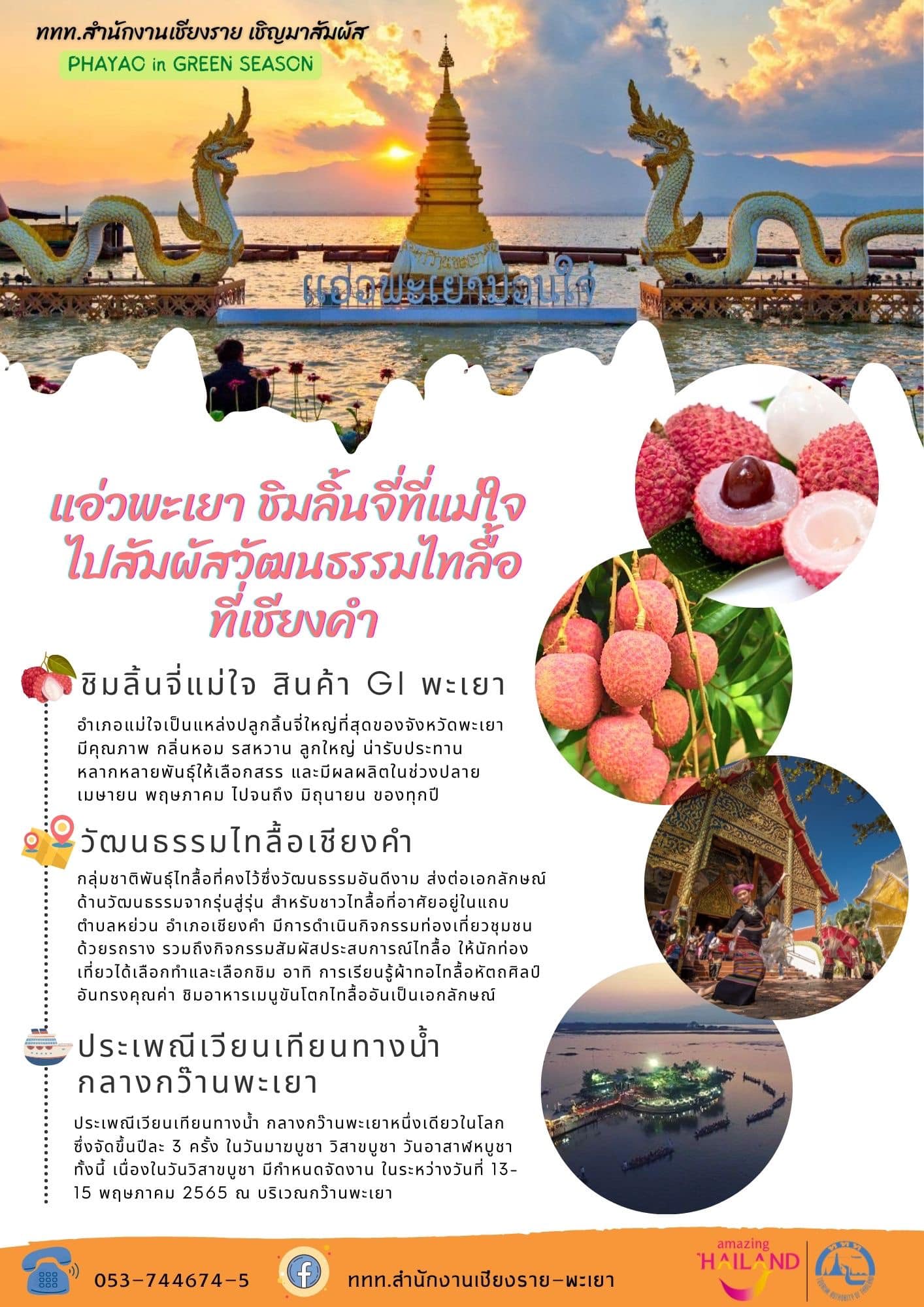Phu Sang National Park (อุทยานแห่งชาติภูซาง) is a part of Doi Pha Mon Mountain Range in King Amphoe Phu Sang, Chiang Kham District, Phayao, and Theong District, Chiang Rai, with a 30-kilometre boundary, connecting to the Lao People’s Democratic Republic, covering a total area of 178,049 rai. Within the area are hill evergreen forest, dry evergreen forest and mixed deciduous forest. The precious plants include Yang – Dipterocarpus alatus, Takhian – Hopea odorata, Champi Pha – Michelia floribunda, cigar-box cedar, Burma Padauk, teak, Rang – Shorea siamensis, etc. This area comprises high and undulating mountain ranges where the summit of Doi Pha Mon, an original source of the Lao, Pueai, Bong, and Yuan Rivers, nurturing the agricultural sites of Chiang Kham District, Phu Sang Minor District in Phayao Province, and Thoeng District in Chiang Rai Province, is located. Apart from the perfect natural condition, the national park is also a habitat of Pu Lu or Siamese big-headed turtles, a rare and endangered species of turtle. This kind of turtle is small, short, has a long tail and big head. As their head is large, their 4-legs and tail cannot be drawn back into their shell. When their enemies or danger approach, especially forest fire, the turtles are usually killed by the fire. Therefore, Pu Lu turtles have become a symbol of the prevention of forest fire in Thailand. The Pu Lu turtles stay in the abundant forests on the high mountains, near the waterfalls or creeks with clean and clear water flowing throughout the year. The turtles can be observed during the nighttime, while they are searching for food.
Interesting attractions within the national park are as follows:
Namtok Phu Sang (น้ำตกภูซาง) is a 25-metre-high limestone waterfall with a stream throughout the year. The water in this waterfall is 33ºC warm and clear without the smell of sulphate. Its basin is suitable for bathing. The waterfall is located by the road, 300 metres from the Office of the National Park. On its opposite side is located a welfare shop where visitors can take a rest and have a meal.
Phu Sang Warm Spring (บ่อน้ำอุ่นภูซาง) is a seepage whose water is a headspring of the Phu Sang Waterfall with a temperature of 35ºC. It is situated upstream of the Phu Sang Waterfall. The surroundings are abundant evergreen forest and freshwater swamp forest.
Tham Pha Daeng (ถ้ำผาแดง) is a large-size limestone cave with a depth of approximately 450 metres. Within the cave are beautiful stalactites and stalagmites. It is located 48 kilometres from the Office of the National Park. A ranger leading a visit to the cave is a must. Please inform the national park in advance for a visit.
Tham Nam Lot (ถ้ำน้ำลอด) is a small stone cave located at the foot of Doi Pha Daeng, approximately 10 metres from Tham Pha Daeng. The cave is 250 metres deep with a stream flowing through the cave. The level of the water is 50-100 centimetres deep. Visitors have to wade through the water during their cave visit and a ranger leading the visit is necessary.
Doi Pha Dam (ดอยผาดำ) is a limestone mountain where stands a large cliff, a beautiful sculptural art of the nature. It is 1,096 metres above sea level. Doi Pha Dam overlooks the Phu Sang National Park’s Ranger Station 1 (Pha Daeng) within the compound of Rom Yen Sub-district, Chiang Kham District, Phayao Province. It is 47 kilometres from the Office of the National Park. It takes 3-4 hours for a walking tour and a ranger leading the tour is necessary.
Tham Luang (ถ้ำหลวง) is a large limestone cave. It is quite wide but not deep, with a width of approximately 200 metres. It is a location of the Ranger Station 2, Huai Sa. Tham Luang is 500 metres from the station and 32 kilometres from the Office of the National Park. Visitors have to slightly climb up the mountains to the cave and a ranger leading the trip is obligatory.
Tham Nam Dang (ถ้ำน้ำดัง) is a large cave where there is a waterfall and beautiful stalagtites and stalagmites located inside. It was once a secret refuge of the Pho Ko Kho – the Communist Insurgents.
The Nature Study Route There are overall 3 routes in the national park with a distance of 1,400 metres (Huai Miang Route), 1,700 metres (Phu Sang Waterfall Route), and 2,400 metres (Huai Sa Route). Each of them takes approximately 2 hours for a trekking tour. There are also interpretation signs along the route; therefore, visitors can take a walk by themselves.
Pu Lu or Siamese Big-headed Turtles (เต่าปูลู) are a rare and endangered species of turtle whose origin is in the Upper North and along the frontier connecting to Myanmar, and the southern part of China. Their unique characteristics are shortness, with dark green to black shell, with a length of approximately 15-20 centimetres. The distinctive point is that their tail is lined up in segments and longer than their shell. Therefore, they are not able to draw their head, legs, and tail into their shell. They are very good at climbing by using their nails and tail. Pu Lu turtles search for food during the night. They eat shrimp, shells, crabs, and fish, but not vegetables. During daytime, they usually hide in between the gaps of cold stones. Moreover, in winter, they will hibernate.
The National Park provides accommodation, camping areas, as well as, a welfare shop for tourists. For further information, please contact the Phu Sang National Park, Mu 10, Phu Sang Sub-district, Phu Sang Minor District, Phayao Province 56110, Tel: 0 5440 1099.
To get there: The National Park is located 90 kilometres from Phayao Province. Take the Phayao – Dok Khamtai – Chun – Chiang Kham – Thoeng Route, 6 kilometres from Chiang Kham District. Turn right into Highway No. 1093 for 17 kilometres from Chiang Kham. Prior to Phu Sang Witthayakhom School, turn right and pass the Phu Sang Minor District Office. Otherwise, travel from Chiang Rai Province – Thoeng – Chiang Kham route. The total distance is 100 kilometres along Highway No. 1021.
By bus: Take the Phayao – Chiang Kham District Bus or Chiang Rai – Chiang Kham District Bus and continue by mini bus, routing Chiang Kham – Ban Huak. The bus will pass the Office of the National Park along Highway No. 1093, a distance of 20 kilometres.




